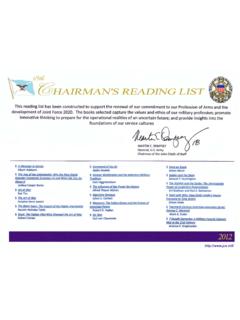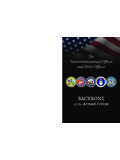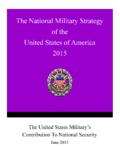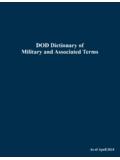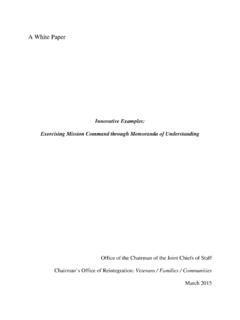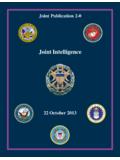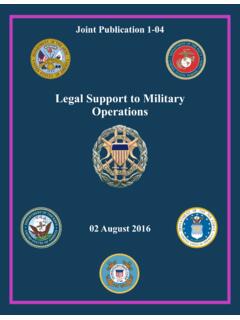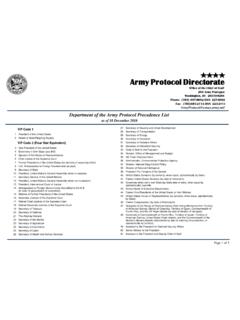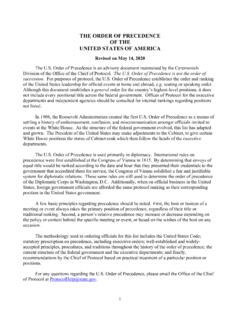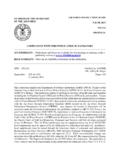Transcription of Joint Fire Support - Joint Chiefs of Staff
1 DEPAOTMENTFTHEARMY EUNITEDSTATSOAFAMERICRTHISWE'LLDEFENDJ oint Publication 3-09 Joint Fire Support10 April 2019 i PREFACE 1. Scope This publication provides fundamental principles and guidance for planning, executing, and assessing Joint fire Support . 2. Purpose This publication has been prepared under the direction of the Chairman of the Joint Chiefs of Staff (CJCS). It sets forth Joint doctrine to govern the activities and performance of the Armed Forces of the United States in Joint operations, and it provides considerations for military interaction with governmental and nongovernmental agencies, multinational forces, and other interorganizational partners. It provides military guidance for the exercise of authority by combatant commanders and other Joint force commanders (JFCs), and prescribes Joint doctrine for operations and training.
2 It provides military guidance for use by the Armed Forces in preparing and executing their plans and orders. It is not the intent of this publication to restrict the authority of the JFC from organizing the force and executing the mission in a manner the JFC deems most appropriate to ensure unity of effort in the accomplishment of objectives. 3. Application a. Joint doctrine established in this publication applies to the Joint Staff , commanders of combatant commands, subordinate unified commands, Joint task forces, subordinate components of these commands, the Services, and combat Support agencies. b. This doctrine constitutes official advice concerning the enclosed subject matter; however, the judgment of the commander is paramount in all situations. c. If conflicts arise between the contents of this publication and the contents of Service publications, this publication will take precedence unless the CJCS, normally in coordination with the other members of the Joint Chiefs of Staff , has provided more current and specific guidance.
3 Commanders of forces operating as part of a multinational (alliance or coalition) military command should follow multinational doctrine and procedures ratified by the United States. For doctrine and procedures not ratified by the United States, commanders should evaluate and follow the multinational command s doctrine and procedures, where applicable and consistent with US law, regulations, and doctrine. For the Chairman of the Joint Chiefs of Staff : DANIEL J. O DONOHUE Lieutenant General, USMC Director, Joint force Development Preface ii JP 3-09 Intentionally Blank iii SUMMARY OF CHANGES REVISION OF Joint PUBLICATION 3-09 DATED 12 DECEMBER 2014 Adds synchronize and integrate fires and airspace to the list of Joint fires processes and tasks. Expands the discussion of no-strike list and restricted target list to separate the two and clarify the importance of each.
4 Expands the discussion of space and cyberspace. Expands the discussion of the coordination between operations and intelligence directorates during planning, execution, and assessment, and clarifies operations responsibilities during targeting. Adds representation from the space component, the civil-military directorate, and nongovernmental organizations to the typical Joint fires element; reflects the direct participation of interagency partners and the national intelligence community. Adds fires deconfliction and cross-boundary coordination procedures to the list of items addressed in the Joint force commander s guidance for Joint fire Support . Simplifies the discussion of Joint fire Support planning during the Joint planning process. Adds a discussion on the Joint targeting cycle and its use as a framework for Joint fire Support planning during execution.
5 Adds a section in the execution chapter on dynamic targeting, to include a discussion of the missions used to conduct Joint fire Support using dynamic targeting procedures. Adds a section in the execution chapter on air operations in maritime surface warfare. Deletes information on lasers and laser-guided systems that is tactical in nature and which is found in multiple Service publications. Modifies the definitions of coordinated fire line, fire Support , fire Support coordination, fire Support coordination center, fire Support coordinator, forward observer, free fire area, laser-guided weapon, laser target Summary of Changes iv JP designator, phase line , restrictive fire area, restrictive fire line, shore fire control party, spotter, and zone of action.
6 Moves nonlethal weapon to Joint Publication 3-09, Joint Fire Support , as source and modified the definition. Removes the terms grid coordinates and inertial navigation system from the DOD Dictionary of Military and Associated Terms. v TABLE OF CONTENTS EXECUTIVE SUMMARY .. vii CHAPTER I Joint FIRE Support OVERVIEW Introduction .. I-1 Scheme of I-1 Joint Fires .. I-3 Joint Targeting .. I-3 Target Engagement .. I-4 Assessment .. I-5 CHAPTER II Joint FIRE Support COMMAND AND CONTROL Introduction ..II-1 Employment Considerations ..II-1 Synchronization of Fires with Movement and Maneuver ..II-3 Structure and Functions ..II-4 CHAPTER III Joint FIRE Support PLANNING Introduction .. III-1 III-1 Joint Fire Support and force Capabilities .. III-7 Joint Fire Support Planning.
7 III-14 CHAPTER IV Joint FIRE Support EXECUTION Introduction .. IV-1 IV-1 The Joint Targeting Cycle .. IV-3 Employment of Joint Fires .. IV-6 Dynamic Targeting Find, Fix, Track, Target, Engage, and Assess .. IV-13 Air Operations in Maritime Surface Warfare .. IV-15 CHAPTER V Joint FIRE Support ASSESSMENT Introduction .. V-1 V-1 Process .. V-2 Results and Products .. V-6 Table of Contents vi JP 3-09 APPENDIX A Coordination and Control Measures .. A-1 B Lasers and Laser-Guided Systems ..B-1 C Points of Contact ..C-1 D References .. D-1 E Administrative Instructions .. E-1 GLOSSARY Part I Abbreviations, Acronyms, and Initialisms .. GL-1 Part II Terms and Definitions .. GL-6 FIGURE I-1 Joint Fires Processes and Tasks .. I-2 II-1 Typical Joint Fires Element ..II-7 IV-1 Joint Targeting Cycle.
8 IV-4 V-1 Notional Assessment Plan Development Matrix .. V-4 A-1 Fire Support Coordination and Maneuver Control Measures .. A-4 A-2 Fire Support Coordination Line .. A-7 vii EXECUTIVE SUMMARY &2MM$1'(R 6 29(R9,(: Provides an overview of Moint fire Support , scheme of fires, and the relationship between Moint fire Support and Moint targeting. 'escribes Moint force command structure and function, component fires command and control organizations, and Support relationships employed to conduct Moint fires. Presents the Moint fire Support planning process, both pre-e[ecution operations planning and during e[ecution Moint targeting cycle . 'iscusses considerations and factors involved during Moint fire Support e[ecution. Presents the process to assess Moint fire Support . J2,17 ),R( 68PP2R7 29(R9,(: Joint Fire Support Joint fire Support is Moint fires that assist air, land, maritime, space, cyberspace, and special operations forces to move, maneuver, and control territory, airspace, space, cyberspace, the electromagnetic spectrum, and Ney waters and to influence populations.)))))]]]
9 Joint fire Support helps create conditions that provide the supported commander freedom of action. Joint fire Support is achieved through coordinated interaction of all of the elements of the fire Support system, thorough and continuous planning, aggressive coordination, and vigorous execution. The Joint force commander (JFC) is responsible for all aspects of Joint fire Support planning, prioritization, coordination, execution, and assessment. The JFC and component commanders, with the assistance of their staffs, integrate and synchronize Joint fire Support in time, space, and purpose to increase the effectiveness of the Joint force . Scheme of Fires 7he commander communicates the Moint fire Support plan through use of the scheme of fires an integral part of the commander s concept of operations (CONOPS).
10 The scheme of fires describes how to coordinate and synchronize the use of tactical, Executive Summary viii JP 3-09 operational, and strategic fires capabilities to create the JFC s desired lethal and nonlethal effects and achieve the desired objectives. Relationship with Joint Targeting Fires is a Joint function related capabilities and activities grouped together to help commanders synchronize, integrate, and direct Joint operations. Joint fire Support and Joint targeting are fundamental tasks of the fires function with a unique relationship. The Joint targeting process matches and integrates appropriate Joint fires capabilities to validated targets to create desired effects and outcomes. J2,17 ),R( 68PP2R7 &2MM$1' $1' &217R2/ Command Relationships The JFC establishes clear supported and supporting command relationships that define the roles and responsibilities for Joint fire Support planning and execution.
